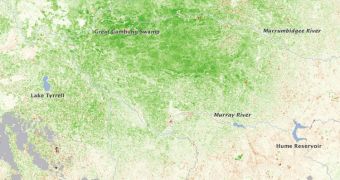The Australian “Wheatbelt,” an area of the country that, as the name implies, is responsible for producing the majority of the country's grains, has just turned green from yellow, after being drenched by powerful rains.
This change in fortune for farmers in the area came in late 2010, and was so intense that it could also be witnessed from satellite, as evidenced by the attached image, snapped by a NASA satellite.
After three consecutive years of drought, the rains came as a blessing for the entire region, and for the nation as a whole. The Wheatbelt is located in southeastern Australia.
The regions of New South Wales and Victoria got record-setting precipitation level in August, but even more came in September, which was the wettest September in recorded history.
According to the Australian Bureau of Meteorology, average rainfall in the Wheatbelt ranged from average in some ares to significantly above average in others.
“This vegetation image shows how plants responded to the rainfall along the border between Victoria and New South Wales, in the Murray River basin,” a NASA Earth Observatory press release says.
“It was made from measurements taken by the Moderate Resolution Imaging Spectroradiometer (MODIS) on NASA’s Terra satellite between September 7 and 22, 2010, compared to average conditions during the same period from 2000 to 2009,” it adds.
The difference is astounding, as demonstrated that the predominance of the color green throughout the image, where yellow was pervasive the previous years. This is a clear indicator that plants are growing more robustly this year.
Crop fields, seen here as tiny squares and rectangles, mingle with smooth, lush natural vegetation, that did not exist the past three years. Overall, the aspect of the region is more continuous.
“In general, the natural vegetation responded to the rain more than nearby crops, though this may be a matter of timing,” NASA officials add. s
“Many of the crops that grow in northern Victoria and southern New South Wales – including corn, sorghum, rice, cotton, millet, and potatoes – are usually planted beginning in September or October,” they add.
But the rain boosted the growth of cotton significantly, and so the country is expecting record harvests this year. Another positive aspect of the situation is that more water became available for irrigation.
Reservoirs alongside the Murray River basin were replenish, and so supplies are ensured for the immediate future, farmers say. But not all consequences were positive, experts at the American space agency say.
“Rivers throughout eastern Australia flooded. The lush vegetation and water supply created habitat for plague locusts; swarms of them were reported along the Murray River in early December,” they conclude.

 14 DAY TRIAL //
14 DAY TRIAL //